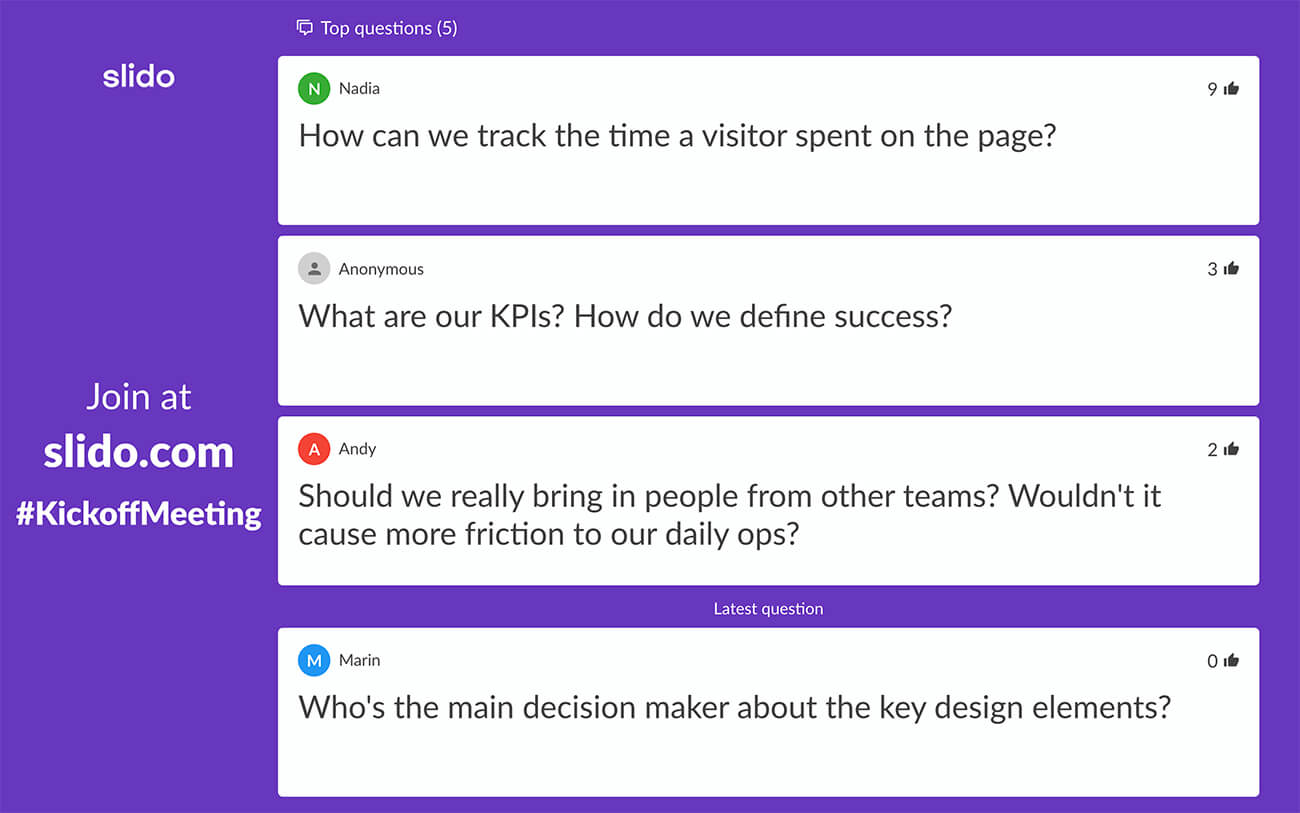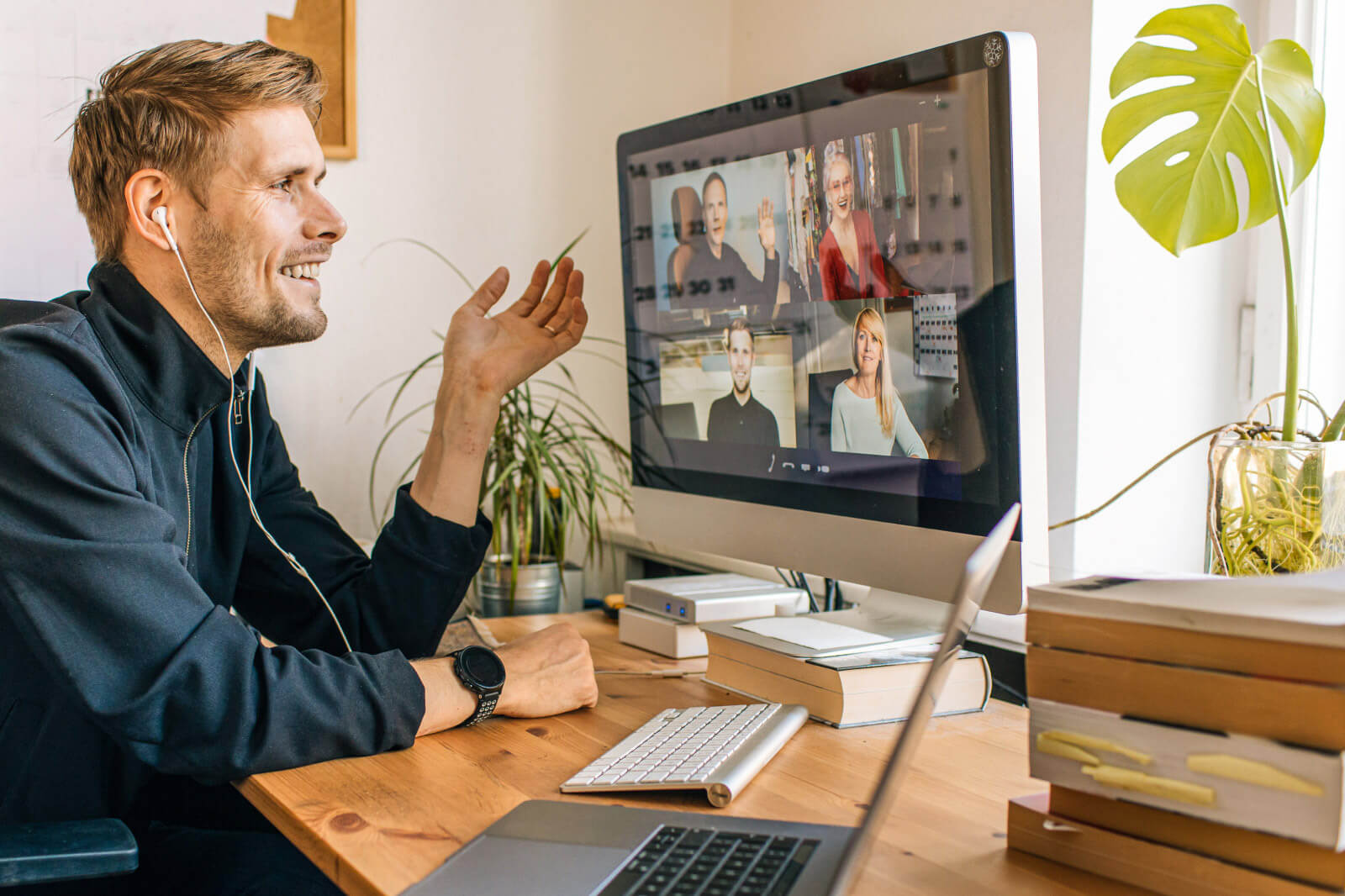A Q&A session has the potential to be the most important part of your company meetings.
It’s a way to give employees a voice – a chance to ask questions to leadership and raise any concerns.
On the other hand, Q&As allow leaders to connect with employees at scale and in turn, create trust within the company.
Hybrid work has made this more important than ever.
Especially at larger online meetings such as all-hands and town halls, there aren’t many opportunities for employees to speak up and be heard.
In this article, we’ll show you how to design and facilitate a successful Q&A session at your hybrid company meetings.
What you’ll learn:
- What is a Q&A session?
- Why is Q&A important?
- How to set up and facilitate a Q&A session at your meeting
Let’s dive right in.
What is a Q&A session?
Q&A (Questions-and-Answers) sessions are formats that allow audiences to ask questions to the speakers. Q&As originate in the events industry, where short Q&A blocks are typically held after each speaker slot to engage the audience and give them a chance to ask the speaker additional questions.
Q&A sessions have also found their way into companies. Many companies made Q&A sessions a regular part of their all-hands meetings or town hall meetings to allow for a communication flow between their employees and leadership.
Others, like Slack, Facebook, or IBM run standalone “Ask Me Anything” sessions with their CEO and executives.
Why is Q&A important?
Running a Q&A session is important because it helps bridge the gap between employees and company executives. When done over time, this builds a trusted and transparent culture and promotes inclusion and diversity in the workplace.
Effective internal communication
Since hybrid work has made interactions between employees and leadership even more scarce, Q&A sessions provide an important avenue for effective internal communication.
Transparency & Trust
Open Q&As help leaders keep healthy two-way communication with their staff, which is an important factor for employees to trust their leaders.
Diversity & Inclusion
By opening a forum for employee questions, companies give their employees a voice and support diversity of thought and opinion in the workplace.
Read also: Employee interaction is the tip of the meeting iceberg
How to set up and facilitate a Q&A session at your meeting
Below, you’ll find the best practices that will help you pull off a successful Questions-and-Answers session at your company meeting.
Or would you rather watch a video? Here you are:
1. Include Q&A directly in your agenda and dedicate enough time to it
Make the Q&A section a fixed part of your all-company meeting agenda to keep a regular communication flow with your employees. Running regular Q&A sessions will also help you keep an eye on the overall atmosphere in your organization and detect any changes or patterns.
Also, make sure to dedicate a substantial amount of time to the Q&A part. Only then will you create a meaningful discussion with your staff.
A rushed Q&A session may fail to hit the mark, and even backfire – your employees may feel as though leaders don’t care about their questions and concerns.
- At Slido, we allocate one-third of our all-hands meeting agenda to the Q&A – out of a 90-minute meeting, we spend 30 minutes answering questions from our teammates.
- At Google, a Q&A makes up one-half of their weekly all-hands meetings called TGIF – they run a 30-minute meeting, followed by a 30-minute Q&A with Google’s founders, Larry Page and Sergey Brin.
2. Collect questions from your employees via a Q&A platform
At large company meetings, and especially when run online, it’s impractical to have people ask questions verbally. Not only does it create friction (people unmuting themselves, or jumping in the discussion), but it also isn’t inclusive of those who aren’t comfortable with speaking up.
By using Slido Q&A, you can allow everyone to ask questions asynchronously in advance at a time that suits them best, no matter what their timezone.
All they have to do is simply type their questions in the app (they can even stay anonymous) – and you’ll run more organized Q&A sessions.

Plus, you will have all the questions in one place. During the Q&A, you can display them on the screen and make it easier for your team to follow the discussion.
💡 Tip
If your company’s new to Slido, give it a proper introduction among your employees. Explain to your employees how they can join your Slido event and send their questions in.
3. Start collecting questions from employees in advance
Allow your employees to submit their questions even before the meeting. They will have more time to think their questions through and your leaders will have an opportunity to check the questions before the meeting and prepare more elaborate answers.
For example, we share a link to Slido Q&A with our colleagues about a week before the all-hands meeting.

You can share a link to your Slido event via:
- Slack
Share a link to Slido Q&A with your colleagues in a dedicated Slack channel - Calendar
Paste the link to the calendar invite, along with a Zoom link, and other important details - Email
Send the Slido link to your colleagues in an invite email and encourage them to submit their questions
💡 Tip
By collecting questions in advance, even those who can’t join the meeting in person will be able to ask questions. They will see their question answered when they watch the meeting recording.
4. Appoint a Q&A moderator
To make your Q&A even more effective, have a dedicated person to moderate the discussion. What actually works really well is running your Q&A session as a natural conversation.
Have your moderator read each question out loud and assign it to a concrete person to answer it. This will take your Q&A session from one to 100 and will be much more engaging for your audience to watch and listen to.
A good Q&A moderator will also help keep the discussion organized and relevant by grouping similar questions together, or following up on some of the questions to get the best answers.
💡 Tip
Especially with larger meetings, it’s handy to appoint someone to review the incoming questions, archive duplicate questions or those already answered, and highlight the current questions.
5. Keep reminding people to ask questions
Even if you’ve collected some questions in advance, a good practice is to give your employees a gentle reminder at the beginning of the meeting so they don’t forget to ask questions.
Have your moderator encourage people to keep sending their questions throughout the meeting and repeat the call to action by the end.
Our all-hands moderator, Juraj Holub, often does this trick: After a block of business updates, he prompts people to take a moment, think of what they’ve just heard, and then submit a question should they have one.
6. Use upvotes to keep the discussion relevant
‘Question upvotes’ is a fantastic feature that allows employees to influence which questions will get answered with priority. They can simply give a question a thumbs up to upvote it if they think it’s relevant. You can even enable downvotes that allow them to do the very opposite – send the question down.
It’s a great way to keep the discussion relevant and to the point. Also, it allows employees to express their support for certain questions or topics, even if they don’t want to ask a question themselves.
💡 Tip
Shortly before the end of your Q&A, ask your employees to open Slido and go through the submitted questions once again and upvote them.
You can say something like: “We have time for two more questions, please go ahead and upvote your favorite ones so we’ll get to answer the most relevant ones.”
7. Tackle the unanswered questions after the meeting
If you’ve run out of time and there are still many questions left unanswered, don’t let them disappear.
Answer them in writing, include them in your internal newsletter, or record a video and share it with your teammates afterwards.
Here are 8 tips on what to do with unanswered questions after your all-hands meeting.
Wrap up
A great Q&A session is usually a combination of thoughtful preparation, masterful moderation and skillful use of interaction technology. And, naturally, an intelligent and curious audience population. Use the tips above to make your next Q&A a success.
Improve your Q&A with Slido.




